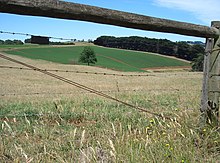Gippsland
This article needs additional citations for verification. (December 2007) |
| Regions of Gippsland |
|---|


Gippsland is a large rural region in Victoria, Australia. It begins immediately east of the suburbs of Melbourne and stretches to the New South Wales border, lying between the Great Dividing Range watershed to the north and Bass Strait to the south. The region is best known for its primary production such as mining, power generation and farming as well as its tourist destinations— Phillip Island, Wilsons Promontory, the Gippsland Lakes, Walhalla, the Baw Baw Plateau, and the Strzelecki Ranges.
The Australian Bureau of Statistics 2006 Census reported a population of 239,647 for Gippsland: 80,115 in East Gippsland, 52,377 in South Gippsland, 33,632 in West Gippsland, and 73,477 in the Latrobe Valley statistical divisions.[1]
History
The area was originally inhabited by Indigenous Australians of the Gunai nation and parts of the Bunurong nation. After European invasion, Samuel Anderson,[2] a Scottish immigrant and early explorer who landed in Hobart Tasmania in 1830 established the third permanent settlement in Victoria at Bass in 1835.His business partner Robert Massie joined him in 1837. Both had worked for the VDL Co based at Circular Head Tasmania.Samuels brothers Hugh and Thomas arrived at Bass shortly after. Sealers and wattle bark gatherers had frequented the area but not settled. Further European settlement began following two separate expeditions to the area. Angus McMillan led the first European expedition through the area between 1839 and 1840, naming the area "Caledonia Australis".[3] This was followed in March 1840 by Polish explorer Paweł Edmund Strzelecki, who unknowingly led his expedition across the same terrain already encountered by McMillan, renaming many natural landmarks and places. Following these expeditions, the area was officially given the title of "Gippsland", a name chosen by Strzelecki in honour of the New South Wales Governor, George Gipps, his sponsor.[4]
Geography

Gippsland is traditionally subdivided into four or five main regions:
- West Gippsland (roughly equivalent to the Shires of Cardinia and Baw Baw)
- South Gippsland (Bass Coast and South Gippsland Shires)
- the Latrobe Valley (Latrobe City and areas of Baw Baw to the north)
- East Gippsland (Shires of Wellington and East Gippsland).
- Sometimes a fifth region, Central Gippsland (corresponding approximately to the Shire of Wellington), is added to refer to the drier zone between the Gippsland Lakes and Yarram.
Climate

The climate of Gippsland is temperate and generally humid, except in the central region around Sale, where annual rainfall can be less than 600 millimetres (24 in). In the Strzelecki Ranges annual rainfall can be as high as 1500 millimetres (60 in), whilst on the high mountains of East Gippsland it probably reaches similar levels - much of it falling as snow. In lower levels east of the Snowy, mean annual rainfall is typically about 900-950 millimetres (35–37 in) and less variable than in the coastal districts of New South Wales. Mean maximum temperatures in lower areas range from 24 °C (75 °F) in January to a pleasant 15 °C (59 °F) in July. In the highlands of the Baw Baw Plateau and the remote Errinundra Plateau, temperatures are very pleasant in summer, ranging from a maximum of 18 °C (64 °F) to a minimum of 8 °C (46 °F). However, in winter, mean minima in these areas can be as low as -4 °C (25 °F), leading to heavy snowfalls that often isolate the Errinundra Plateau between June and October.
In June 2007 there was a flood affecting all of Gippsland but most especially East Gippsland, causing all rivers to have flood warnings and flooding the Bairnsdale caravan park.
Natural resources

The soils in Gippsland are generally very infertile, being heavily deficient in nitrogen, phosphorus, potassium and calcium. Apart from frequently flooded areas, they are classed as Spodosols, Psamments and Ultisols. Consequently, heavy fertilisation is required for agriculture or pastoral development, but with this parts of Gippsland have become highly productive dairying and vegetable-growing regions: the region supplies Melbourne with most of its needs in these commodities. A few alluvial soils (chiefly near the Snowy) have much better native fertility, and these have always been intensively cultivated. In the extreme northeast is a small section of the Monaro Tableland used for grazing beef cattle.
Though Gippsland possesses very few deposits of metallic minerals (gold rushes in the nineteenth century around Foster, Buchan petered out quickly). However, the deep underground gold mines operated at Walhalla for a fifty year period between 1863-1913. Gippsland has no deposits of major industrial nonmetallic minerals, but it does feature the world's largest brown coal deposits and, around Sale and offshore in the Bass Strait, some of the largest deposits of oil and natural gas in Australia.
Like the rest of Australia, the seas around Gippsland are of very low productivity as there is no upwelling due to the warm currents in the Tasman Sea. Nonetheless, towns such as Marlo and Mallacoota depended for a long time on the fishing of abalone, whose shells could fetch very high prices because of their use for pearls and pearl inlays.
See also
References
- ^ Australian Bureau of Statistics (25 October 2007). "Community Profile Series: Gippsland (Statistical Region)". 2006 Census of Population and Housing. Retrieved 6 October 2007.
- ^ The Andersons of Westernport "Horton and Morris"
- ^ "McMillan, Angus (1810-1865)" Australian Dictionary of Biography, online edition. Retrieved on 6 October 2007.
- ^ Wells, J. (2003), "Colourful Tales of Old Gippsland", p. 92.
